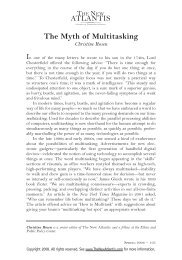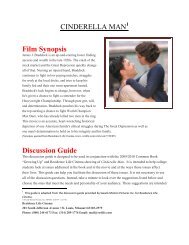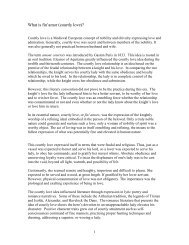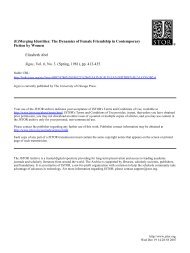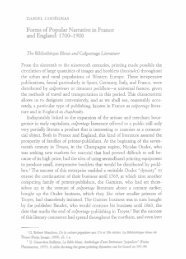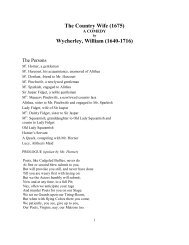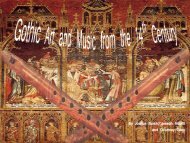Courbet's Exhibitionism
Courbet's Exhibitionism
Courbet's Exhibitionism
Create successful ePaper yourself
Turn your PDF publications into a flip-book with our unique Google optimized e-Paper software.
COURBET' S EXHIBITIONISM<br />
In a letter to his patron Bruyas, Courbet described<br />
his vision of the show he planned to mount for the 1855<br />
Universal Exposition: "From here I can already see an<br />
enormous tent with a single column in the center; for<br />
walls, scaffolding covered with canvas, all mounted on<br />
a platform; then the employees, a man in a black suit<br />
minding the office, opposite the canes and umbrellas,<br />
then two or three ushers. This will really be enough to<br />
make Paris dance on its head. It will be without question<br />
the best comedy that's been played in our times; there<br />
are some people who will get sick over it, that's for<br />
sure"~. Across the letter he sketched a tent (fig. 1). In<br />
reality, as a newly discovered photograph shows<br />
(fig. 14), <strong>Courbet's</strong> pavilion was rectangular, not a tent<br />
at all, and this drawing, appearing across an unpub-<br />
lished letter, was a private fantasy rather than a public<br />
fact. And yet the public did apprehend his gesture, even<br />
without benefit of his drawing. On reading his letter<br />
today we might well wonder: Who would laugh at this<br />
comedy, and who would get sick over it ? What was<br />
the nature of <strong>Courbet's</strong> exhibitionism" ? - a word en-<br />
tirely relevant, as we shall see, to the contemporary dis-<br />
course surrounding this artist. By placing in context the<br />
various aspects of <strong>Courbet's</strong> endeavor as they appeared<br />
to his contemporaries, we can gain a more profound<br />
sense of the reasons for which he was both praised and<br />
damned in his own time.<br />
Although the negative criticism which first greeted<br />
<strong>Courbet's</strong> work has been taken by modernists as a par-<br />
adigmatic example of the persecution of the avant-garde<br />
artist by an uncomprehending public, I have argued<br />
elsewhere that Courbet in 1855 was actually supported<br />
by the professional artists' periodicals 2 . La Revue universelle<br />
des Arts, La Revue des Beaux-Arts, Journal des<br />
Arts, L'Artiste, all either praised him or were sympa-<br />
thetic to his plight. The most savage attacks in 1855<br />
came from critics and caricaturists working for periodi-<br />
cals of the conservative right, such as A.J. Du Pays and<br />
BY<br />
PATRICIA MAINARDI<br />
e - 1 Q4'<br />
Q ulenbots in L'Olustrationj . Nonetheless, as this nega-<br />
tive criticism ha always taken center stage, it is im-<br />
portant to explo e the nightmare vision that Courbet<br />
presented to aest etic and political conservatives.<br />
FIG. 1. - Gustave COURBET. Autograph letter with a sketch of<br />
the 1855 Pavilion.
254<br />
Today we focus on <strong>Courbet's</strong> gesture of mounting<br />
his show and we see it as a gesture of defiance to the<br />
government that had rejected both his Studio and his<br />
Burial; indeed it was, as Champfleury wrote at the time,<br />
"an incredibly audacious act" 4 . Our focus on the gesture<br />
fits in well with modem political imperatives, the heroicization<br />
of the individual standing alone against an unjust<br />
state. The issues embodied in <strong>Courbet's</strong> gesture,<br />
Individualism, Self-confidence, Defiance, Genius, are<br />
all qualities which define the modern - usually male -<br />
hero. They are also, however, qualities which define the<br />
self-made man of early capitalism, the entrepreneur.<br />
FIG. 2. - Title Page, Catalogue of <strong>Courbet's</strong> 1855 Exhibition.<br />
GAZETTE DES BEAUX-ARTS<br />
This latterlreferent has been largely ignored by art historians,<br />
but both interpretations, defiant hero and entrepreneur,<br />
should be explored, for in the nineteenth<br />
century, they were by no means mutually exclusive.<br />
To begin to see <strong>Courbet's</strong> exhibitionism as his contemporarie''s<br />
would have seen it, we will have to understand<br />
firstl, the exhibition structure as they saw it,<br />
second, traditional exhibition sites as they understood<br />
them, and third, the decorum of exhibitions at that time,<br />
for <strong>Courbet's</strong> gesture could only assume meaning<br />
against the commonly accepted fabric of expectations<br />
and procedures. In giving the broad outlines of these<br />
issues, it trust be stressed that, although I am here focusing<br />
on the negative, contemporary opinion held<br />
various attitudes, both positive and negative, towards<br />
each.<br />
Throu0out most of the nineteenth century, the major<br />
event in I-Irench exhibition practice was the Salon, the<br />
annual, sometimes biennial, exhibition of contemporary<br />
art. Until the 1789 Revolution, it had operated as a monopoly,<br />
controlling French artistic life and careers. Only<br />
members Of the Academy could participate and alternative<br />
exhibitions were suppressed. The Academy had<br />
been founded and was maintained as the Government<br />
agency in charge of aesthetics: its members received<br />
salaries a~d studios, and State commissions were originally<br />
reserved for them. Academicians had, however,<br />
elevated their status from that of artisans by rejecting<br />
all hints f commerce and so, in the Academic Salon<br />
of the An ien R6gime, artists did not exhibit works for<br />
sale but "consented to show to a limited public some<br />
pictures commissioned in advance for a specific destination"<br />
5 . !,,Although in reality many Academicians<br />
worked inja variety of modes, this elite attitude towards<br />
art production survived well into the nineteenth century,<br />
defining o~e pole of the spectrum of attitudes towards<br />
exhibition Ipractice. That pole can be summed up in the<br />
word exposition; in both English and French it preserved<br />
thelconnotation of a didactic, morally instructive<br />
show. The word exhibition, on the other hand, while<br />
meaning lin English simply a show, assumed in<br />
nineteenth] century France a pejorative connotation of<br />
ostentation and immodesty. A commercial enterprise,<br />
such as a<br />
as would<br />
hibitionist<br />
hop window display, would be an exhibition,<br />
rsonal behaviour we today would label ex-<br />
This negative attitude towards anything<br />
commercial derived from traditional aristocratic disdain<br />
for corn*rce, which, in the nineteenth century, was<br />
identified ]with England, the leading commercial power<br />
among nations; hence the pejorative use of the English<br />
word exhibition 7. Needless to say, conservative critics<br />
descri<br />
not ai<br />
headi<br />
(fig.<br />
a dish<br />
Ai<br />
mono<br />
princ<br />
the P<br />
ing t(<br />
and i<br />
worl,<br />
Cour<br />
trout<br />
led i<br />
pron<br />
of e<br />
Salo<br />
ser\<br />
whi<br />
indi<br />
peal<br />
ab<br />
den<br />
ech<br />
ass<br />
bay<br />
in()<br />
sat<br />
ha~<br />
we<br />
do<br />
we<br />
th,<br />
to,<br />
re,<br />
si<br />
pr<br />
its<br />
w<br />
th<br />
tt<br />
n<br />
0<br />
l.<br />
d<br />
i
described <strong>Courbet's</strong> 1855 show as an "exhibition" and<br />
not an "exposition". Courbet himself provoked this by<br />
heading his own catalogue EXHIBITION ET VENTE<br />
(fig. 2) "Exhibition and Sale", a title more fitting for<br />
a display of furniture or rugs than of high art s .<br />
After the 1789 Revolution, the Academy had lost its<br />
monopoly over the Salon, which was then opened, in<br />
principle at least, to independent artists. Nonetheless,<br />
the Academy continued to maintain that it was degrading<br />
to make a direct appeal to the public to sell pictures,<br />
and that true artists did not produce easel paintings but<br />
worked on commission for Church and State. The young<br />
Courbet made his entrance to the Salon during the<br />
troubled years of the 1840s when the Academy controlled<br />
the Salon Jury, rejecting works by artists even as<br />
prominent as Delacroix. By the 1848 Revolution, out<br />
of eighteen paintings Courbet had submitted to the<br />
Salon, only two had been accepted.<br />
The 1830s and 1840s were the years in which conservatives<br />
began to criticize the Salon in language<br />
which continued throughout the century as an infallible<br />
indicator of conservative politica 9 . Ingres stated repeatedly:<br />
"The Salon is no longer anything more than<br />
a bazaar, where mediocrity displays itself with impudence"<br />
i0. E.J. Delecluze, the leading conservative critic,<br />
echoed his sentiments: "The Salons in the Louvre have<br />
assumed, more and more each year, the character of a<br />
bazaar, where each merchant is obliged to present the<br />
most varied and bizarre objects in order to provoke and<br />
satisfy the fantasies of his customers" Il . Art historians<br />
have largely ignored the significance of these code<br />
words: exhibition, market, picture shop, bazaar (exhibition,<br />
marche, boutique de tableaux, bazar) pejorative<br />
words never used by critics supportive of what we call<br />
the avant-garde.<br />
Conservatives believed that art was inherently aristocratic<br />
and elitist and that, under a democratic political<br />
regime, mediocrity would reign. Education, they insisted,<br />
was the only legitimate purpose for art, history<br />
painting its only legitimate vehicle, and Academicians<br />
its only legitimate practitioners; the habitus of such art<br />
was the church, the public monument, the museum or<br />
the aristocratic private gallery. The enemy for them was<br />
the bourgeois preference for art as decoration or as commodity.<br />
Such art, they felt, was trivial and commercial,<br />
only fit to be sold at bazaars and market places. Their<br />
language was anachronistic, however, for, as capitalism<br />
leveloped, the site of art distribution became increasngly<br />
the commercial art gallery or the auction house.<br />
through this politico-aesthetic language, of bazaars and<br />
)icture shops, of mediocrity and aristocracy, a political<br />
COURBET'S EXHIBITIONISM 25 5<br />
la do d. Yon E:poeiW~e anlyeraeile, Cooabet Re dtoeioe ! lal-mama<br />
quolquaa rdeompewa Lle~ mfritfea, on prlsence rune multitude choide,<br />
compacts de M. Bra et ton ehiso. -<br />
FIG. 3. - BERTALL in the Journal pour tire, 12 January 1856.<br />
system - democracy I-and an economic system - capitalism<br />
- was being criticized: Courbet, through his 1855<br />
show, symbolized bh institutions.<br />
It is clear that 11855 the two poles of the Salon<br />
were, on the right, elevated, academic exhibition as<br />
close as possible tot the ideals of history painting and<br />
the Ancien Mgime.lOn the left there was the popular<br />
Salon, full of inde p ,~ ndept artists striving to appeal to<br />
the public in order to sell their work. But if, in fact,<br />
the other pole fromIthe aristocratic closed pre-Revolutionary<br />
Salon was tolbe the open, somewhat democratic<br />
and independent Sal n, where does that place <strong>Courbet's</strong><br />
pavilion ? When con ervatives referred to a bazaar, they<br />
were both exaggera ing and speaking metaphorically;<br />
Courbet intentional, produced the very image of their<br />
nightmare, but not i the quaint, sentimentalizing imagery<br />
of a bygone e och, of marche and bazar, but in<br />
the contemporary wo Id of burgeoning mass culture and<br />
commercialism - thel art exhibition as store.
25 6<br />
To place <strong>Courbet's</strong> 1855 show, we must understand<br />
how rare any individual shows were in France. The most<br />
common examples of these events were the posthumous<br />
shows organized for recently deceased Academicians<br />
and held in prestigious locations such as the Ecole itself.<br />
Galleries at this time were still picture shops displaying<br />
and selling a variety of work by a variety of<br />
artists. Artists occasionally held their own shows in<br />
their studios, as David did in 1799 and Horace Vernet<br />
in 1822, but, by being held in their studios, these shows<br />
preserved the dignity of hiO art events, even when they<br />
were intended as protest t . <strong>Courbet's</strong> 1855 show has<br />
always been identified with this tradition, a protest<br />
against the Exposition Jury's refusal of his two major<br />
pictures, The Artist's Studio and A Burial at Ornans<br />
(figs. 12 and 13). And yet even before he submitted his<br />
pictures to the Jury' he had informed Nieuwerkerke, the<br />
Intendant des Beaux-Arts, that he was hoping to mount<br />
a private exhibition to compete with the Universal Ex-<br />
GAZETTE DES BEAUX-ARCS<br />
position, land he had dropped several hints to his patron<br />
Alfred Blruyas that such a show (which he wanted<br />
Bruyas to subsidize) was in the offing l 3. One could<br />
argue that he anticipated that his pictures would be rejected,<br />
but it must also be acknowledged that he very<br />
much wanted, from the beginning, to hold this show<br />
and to hold it on a site identified with the distribution<br />
of art and not its production, in other words, to hold it<br />
as a commercial enterprise. Indeed he had already made<br />
two previlous attempts in this direction in 1850, in Besanrgon<br />
and in Dijon, the first in a market hall, the second<br />
in mouse that also held a cafe. In both cases he<br />
had plastered the town with posters advertising his show<br />
and had charged a fifty centime admission fee t4 . Riat<br />
quotes him as feeling that the peasantry of Omans had<br />
thought he was an idiot because he had let them see<br />
his works! for free, "which evidently proves it's silly to<br />
have a kind heart, for it merely deprives one of funds<br />
without enriching others in spirit or purse. To be free,<br />
"Lis 0Z gBAID®S4lltflI5<br />
4.Tmm wjb~ W. lost I M-11<br />
FIG. 4. - J. JOURDAN, Le Palais de l'Industrie, Tutgis Editeur, Paris, 1855.<br />
peo<br />
swa<br />
so<br />
to t<br />
loc;<br />
in<br />
mu<br />
be,<br />
mo<br />
wh<br />
tale<br />
mu<br />
in<br />
art<br />
ye<br />
ins<br />
in<br />
tip<br />
ha<br />
te-<br />
B(<br />
di<br />
a<br />
fc<br />
tl<br />
a,<br />
R<br />
c<br />
V<br />
p<br />
e<br />
f<br />
I
eople want to pay, so that their judgment won't be<br />
Hayed by gratitude; they are right. I want to learn and<br />
I'll be so ruthless that I'll give everyone the right<br />
15 .<br />
tell me the most cruel truths"<br />
This leads to my second point, the issue of a suitable<br />
)cation for art exhibitions. The annual Salon took place<br />
I the Louvre until 1848 when, evicted from the<br />
tuseum, it began a nomadic existence l 6. Pressure had<br />
egun to mount in the 1830s to evict it from the Louvre,<br />
Iostly coming from conservatives who felt that art<br />
,hich increasingly rejected tradition had no right to par-<br />
Ike of the elevated provenance associated with that<br />
tuseum. The Salons of 1849, 1850-51, 1852, were held<br />
1 the Tuileries and in the Palais-Royal; 1853 presented<br />
rtists with the worst disappointment of all, for that<br />
ear's Salon was held in temporary buildings surround-<br />
Ig the Imperial furniture warehouse at Menus-Plaisirs<br />
i northern Paris. During these years there was con-<br />
,nual talk of suppressing the Salon altogether; Ingres<br />
ad actually recommended such a course when he<br />
:stified before the 1848 Commission permanente des<br />
ieaux-Arts: "In order to remedy this overflow of me-<br />
. iocrities, which has resulted in there no longer being<br />
French School, this banality which is a public misortune,<br />
which afflicts taste, and which overwhelms<br />
he administration whose resources it absorbs to no<br />
vail, it would be necessary to give up expositions..." 17<br />
tumors and uncertainty ran rife through the artists'<br />
ommunity. Would there continue to be a Salon ? If so,<br />
vhere would it be held ? The very future of contem-<br />
>orary art seemed to be at stake during these years, so<br />
'.ourbet's carnival tent would not seem very funny to<br />
hose who feared that contemporary art might end up<br />
xactly there.<br />
Art galleries as we know them were still in their inancy<br />
in the first half of the century. In 1843 the critic<br />
.outs Peisse wrote: "Outside the Louvre there would<br />
Io Ion Rer be a Salon, there would be only picture<br />
,hops" i8. Galleries were then indeed picture shops seling,<br />
indiscriminately, art supplies, curios, and small<br />
>ictures from the lower categories of art - genre, land-<br />
:cape, still life l9 . The common conservative complaint<br />
hat the Salon had become a bazaar or a picture shop<br />
,howed that, in fact, these institutions were seen as the<br />
mly alternative to the museum. So the two poles on<br />
he exhibition spectrum were the Louvre, for exposiions<br />
of educational, historical art, and the picture shop<br />
'or exhibitions of commercially viable, decorative art.<br />
knd yet art dealers at this time were not interested in<br />
)old entrepreneurial initiatives, such as the promotion<br />
Ind marketing of a trademarked product, namely the<br />
COURBET'S EXHIBITIONISM 257<br />
FIG. 5. - Auguste BELIN. "Sortie du Bat de 1' Opdra", Journal<br />
amu$ant, January 1859.<br />
b¢uf 6wt la r~iarrac qiu est tratnh pat lea labor<br />
FIG. 6. - Le Monde Renverse, Pellerin Imprimeur, Epinal, 1829.
25 8<br />
t
in France. It was only because of David's great celebrity,<br />
and the extreme curiosity that his work aroused,<br />
that the public accepted a practice which is repugnant<br />
to all our French customs. Although this mode of exposition<br />
succeeded in that David earned 20,000 francs,<br />
he was harshly criticized, and ever since no artist has<br />
dared try it again"23 . In the heated polemics accompanying<br />
the introduction of admission fees at the 1855 Universal<br />
Exposition, the standard objection was to stress<br />
that, under the longstanding policy of noblesse oblige,<br />
a benevolent state owed to its citizens free access to<br />
those institutions considered spiritually and morally<br />
uplifting, such as churches, schools, libraries, public<br />
monuments, and expositions. Charging admission fees,<br />
it was feared, would lower art exhibitions to the level<br />
of popular entertainment, like theatres 24. Courbet, however,<br />
blatantly moved art into this sphere of commercial<br />
entertainment and self-promotion, with his pavilion<br />
advertising his own name G. Courbet (visible in<br />
COURBET'S EXHIBITIONISM 25 9<br />
FIG. 9. - Gustave COURBET. Les Demoiselles de Village, Salon of 1852. The Metropolitan Museum of Art, Gift of Harry Payne<br />
Bingham, 1940.<br />
fig. 14), as prominently as did the bold red signatures<br />
on his paintings 25 . Charles Perrier, the critic for L'Artiste,<br />
commented Iveryone has seen Monsieur <strong>Courbet's</strong><br />
poster with it$ huge lettering plastered over the<br />
walls of Paris, next o street performers and quack doctors,<br />
inviting the pu~lic to come and pay a franc to see<br />
his exhibition of tlorty pictures of his own work26 .<br />
Bertall's cartoon (fig. 3) "At the end of the Universal<br />
Exposition, Courbet! awards himself some well-merited<br />
honors" criticizes the artist both for commercialism (the<br />
receipt box is prominently displayed) and for immodesty<br />
(he is awardingI himself a laurel wreath). The critic<br />
Ernest Gebauer attacked Courbet in 1855 thus: "M.<br />
Courbet, not satisfied with having eleven pictures in the<br />
Universal Expositio , indulged himself by setting up his<br />
own special exhibition a few steps from Palais des<br />
Beaux-Arts" 27. In other words <strong>Courbet's</strong> show manifested<br />
the requisite commercialism, ostentation, and immodesty<br />
which defined it as an exhibition.
26 0<br />
In addition to the commerce of the picture shop,<br />
<strong>Courbet's</strong> 1855 show also recalled the outdoor fairs, the<br />
immediate predecessors of the resolutely non-commercial,<br />
dignified Salon exhibitions. These lowly antecedents<br />
to the Salon continued to be an unwelcome<br />
memory of the past in the collective memory of Academicians<br />
and conservatives in general; hence their<br />
criticism of the Salon as a bazaar. Joined to this, however,<br />
was an even more frightening spectre of the future:<br />
the commercialization and commodification of art<br />
which, they feared, would happen under capitalism. In<br />
other words, to conservatives <strong>Courbet's</strong> show represented<br />
the worst of both the old and the new systems<br />
of art distribution. For us today it is less shocking and<br />
more laudable to see Courbet raging against an unjust<br />
State than to see him making a crassly commercial gesture.<br />
But to nineteenth century conservatives, it was the<br />
disturbing commercialism of his gesture rather than its<br />
political content that was shocking. After all, in 1855<br />
the political opposition came from both left and right;<br />
with the repeated revolutions and counter-revolutions<br />
which had shaken France since 1789, almost everyone<br />
had had a taste of being in the political opposition at<br />
some time.<br />
II. <strong>Courbet's</strong> <strong>Exhibitionism</strong> as Carnival<br />
GAZETTE DES BEAUX-ARTS<br />
Although I have been reading <strong>Courbet's</strong> exhibitionism<br />
as a function of capitalism and the new economic<br />
and social order, this should be underscored by a second<br />
level of interpretation which compounds the first: <strong>Courbet's</strong><br />
exhibitionism as carnival. If the Louvre, the Palace<br />
FIG. 10. - Gustave COURBET. Le Retour de la<br />
Confirence, 1862. Destroyed.<br />
of ings, represented the aristocratic tradition, and the<br />
Palace of Industry (fig. 4) at the Universal Exposition<br />
represented the challenge launched by capitalism, then<br />
Co rbet's pavilion can be seen as disruptive of both<br />
orders. Carnival, of course, did exactly that. Carnival,<br />
thel period from Twelfth Night (6 January) to Ash Wedne0ay<br />
of each year, culminating in the revelry of Mardi<br />
Gras, celebrated the world-upside-down, the reversal of<br />
thel normal order of events. It was filled with feasting<br />
and drunkenness, dancing and orgies, masquerades and<br />
street theatre. Inversion was its basic premise, satire and<br />
pa ody its means: the lowly were raised up and the<br />
mi hty were abased; social, political, and moral order<br />
cold be safely transgressed. Carnival during the 1830s<br />
an~i 40s had become increasingly political; no one at<br />
-century had forgotten that the February Revolution<br />
of': 1848 had taken place during Carnival and that the<br />
two events had been intertwined in a grotesquely surrealist<br />
spectacle: carnival processions turned into mob<br />
2s<br />
ri<br />
N<br />
U<br />
atmosphere, must be seen as the very antithesis of that,<br />
rigidly controlled and organized. This fact is important<br />
in',order to understand the contrast presented by Courbek's<br />
pavilion, at the very entrance to that Exposition;<br />
it I,fulfilled the carnivalesque function of deflating the<br />
pretentiousness of the mighty. And his gesture was<br />
indeed understood: Le Figaro described <strong>Courbet's</strong> pavilion,<br />
facing the Palais des Beaux-Arts of the Universal<br />
Exposition, as "Guignol's theatre next to La Scala of<br />
M lan ..z9 , ts, carnival floats into insurrectionary wagons<br />
poleon III had certainly not forgotten and his 1855<br />
iversal Exposition, far from having a carnivalesque<br />
that is, the Punch and Judy show, a satirical<br />
and subversive institution of popular culture, juxtaposed<br />
to! its antithesis, the high art opera house.
COURBET'S EXHIBITIONISM<br />
Ever since Meyer Shapiro's brilliant article of 1941<br />
"<strong>Courbet's</strong> Popular Imagery" 30, we have been aware of<br />
the relationship between <strong>Courbet's</strong> art and popular images.<br />
I would like to take that a step further and propose<br />
that <strong>Courbet's</strong> interest was not just in a generalized<br />
popular culture of Epinal prints and the customs of the<br />
rural bourgeoisie, but, with his instinct for the "most<br />
complete expression of a real thing" 31, Courbet focused<br />
on the most subversive and threatening aspect of popular<br />
culture, the only one that had both political overtones<br />
and a revolutionary history, namely carnival.<br />
The political carnivalesque informs <strong>Courbet's</strong> 1855<br />
show. When Courbet wrote that his show "will really<br />
be enough to make Paris dance on its head", his statement<br />
conflated the two major features of carnival, revelry<br />
(fig. 5) with the image of the world-upside-down<br />
(fig. 6). The fear which Champfleury described as the<br />
conservative response to <strong>Courbet's</strong> show ("It's a scandal,<br />
it's anarchy, it's art dragged through the mud, it's<br />
a fairground spectacle") 32 was identical to their fear of<br />
carnival when all social order was transgressed. Taxile<br />
Delord, in Le Charivari described Courbet as a carnival<br />
barker shouting to artists to follow his example and<br />
abandon official expositions; 33 Gavarni drew just such<br />
an image of this popular carnival type as the introductory<br />
plate of "Les Debardeurs" (fig. 7).<br />
Daniel Stern (Marie d'Agoult) published an account<br />
of the invasion of the Tuileries in February 1848 which<br />
gives the flavor of Carnival/Revolution where<br />
masquerade and parody combine. Daumier's cartoon of<br />
the Paris gamin on the throne (fig. 8) is based on this<br />
incident. She wrote: "The children dress themselves up<br />
in velvet robes, turn the golden drapery fringe into belts,<br />
and pieces of tapestry into phrygian caps. The women<br />
pour over their hair the perfume that they find on the<br />
princesses' tables. They rouge their cheeks, cover their<br />
shoulders with lace and furs, decorate their heads with<br />
sprays of jewels and flowers; they deck themselves out<br />
with a kind of burlesque taste parodying extravagant<br />
dress" 34 . Compare this to <strong>Courbet's</strong> Young Ladies of the<br />
Village (fig. 9), criticized by Du Pays in L'/llustration<br />
as "the most anti-picturesque, the most unpleasant thing<br />
in the world: the pretention to elegance flaunted by the<br />
common people"35 . Even in conservative critics'<br />
frequent attacks on Courbet as the "apostle of ugliness",<br />
one can read the world-upside-down, for ugliness was<br />
the reversal of beauty, which to conservatives was the<br />
proper sphere of art.<br />
I am proposing that, if we look at Courbet in the<br />
light of carnival, we can better understand the hysteria<br />
his works provoked in conservative circles. Parody and<br />
26 1<br />
inversion assume a new and sinister dimension in the<br />
raucus Return from the Conference (fig. 10) featuring<br />
drunken priests, or the oversized Beggar's Alms<br />
(fig. 11) which the critic Chesneau claimed represented<br />
France 36 . Courbet constantly reversed the traditional<br />
hierarchical relationship of pictorial category to size: in<br />
paintings such as fhe Stonebreakers, The Grain Sifters,<br />
After Dinner at Ornans, ordinary people are elevated<br />
to a size and status traditionally reserved for gods and<br />
heroes. Parody nd inversion proved more subtle,<br />
though equally disturbing, in A Burial at Ornans<br />
(fig. 12), whose 'enter is the void of death, and whose<br />
red-nosed beadles seem to mock the solemnity of the<br />
event. In the light of Klaus Herding's reading of The<br />
Artist's Studio (fi 13) as an adhortatio ad principem,<br />
the traditional exportation to the ruler, Linda Nochlin<br />
has recently suggested that we might also read this as<br />
world-upside-do n, with the "normal" order of the<br />
world reversed: t~e monarch must now listen and learn,<br />
while the artist & ants the benefit of his example to the<br />
ruler 37 .<br />
FIG. 11. - Gusta~e COURBET. L'Aumone d'un mendiant d<br />
Ornans, 1868. Buprell Collection, Glasgow Museums and Art<br />
Galleries.
262 GAZETTE DES BEAUX-A(ZTS<br />
FIG. 12. - Gustave COURBET. Un Enterrement d Orn4ns, 1849. Paris, Music d'Orsay.<br />
Carnival existed at mid-century as a constellation of that carnival still contained. He created works which,<br />
attitudes and modes of behaviour; Courbet knew just like time bombs, would explode in politically and aeshow<br />
to exploit, under the guise of humor, the threat theticalllY conservative circles.<br />
FIG. 13. - Gustave COURBET, L'Atelier du peintre, alligorie rielle diterm'linant une phase de sept annies de ma vie artistique,<br />
1855. Paris, Muscle d'O0say.<br />
Fr<br />
fry<br />
N<br />
C<br />
O<br />
C<br />
1<br />
1<br />
1
FIG. 1 4. - C. THURSTON THOMPSON. "Fireman's Station and Division Wall be ween the Picture Gallery and Sugar Refinery",<br />
from R.J. Bingham and C.T. Thompson, Paris Exhibition, 1855, Tome I, No. XXXVIII. By Courtesy of the Board of Trustees<br />
of the Victoria & Albert Museum, London.<br />
To his conservative audience, <strong>Courbet's</strong> 1855 show<br />
was certainly an exhibition. He travestied every aspect<br />
of high art practice, ostentatiously and immodestly, and<br />
did so with publicly avowed commercial intent. His<br />
contemporaries saw Courbet the carnival barker presiding<br />
over a disturbing vision of the world-upside-down,<br />
parodying the high, the mighty and the respectable; at<br />
the same time, they saw the spectre he presented of the<br />
COURBET'S EXHIBITIONISM<br />
future of art'', in the capitalist commodity system. For to<br />
true nineteenth century conservatives, the coming of the<br />
new bourgeois economic and social order was the<br />
world -ups id -down. What looks like a contradiction to<br />
us today was, in fact, a single nightmare vision in 1855,<br />
the defiant 11ero and the entrepreneur.<br />
P.M.
264<br />
This research was supported in part by a grant from T e<br />
City University of New York PSC-CUNY Research Award Pr~<br />
gram. An earlier version was read at the Symposium "Courbet<br />
Reconsidered", held at the Brooklyn Museum in 1988 in connection<br />
with the exhibition of the same title.<br />
I would like to express my gratitude to the photography<br />
historian Glenn Willumson who first discovered the photograph<br />
of <strong>Courbet's</strong> 1855 pavilion and made a copy print Of<br />
it available to me, to the historian Ann Ilan-Alter who is culrrently<br />
working on a study of carnival and without whose<br />
generosity I would not have been able to develop these i deaIIP~' ,<br />
and to Bernard Silve and Charles Daudon who helped with<br />
the transcription of the contract for <strong>Courbet's</strong> pavilion.<br />
1. Courbet to Alfred Bruyas, n.d., No. 10 in Courbet letters<br />
at the Biblioth6que nationale, Yb3 1739 (8), published n<br />
"Lettres inddites" L'Olivier, Revue de Nice, 8 (septembre-o -<br />
tobre 1913), 485-90. "Je vois ddjA d'ici tine tente 6norme av c<br />
tine settle colonne au milieu, pour murailles des charpent s<br />
recouvertes de toiles peintrs, le tout month stir tine estrad .<br />
Puis des municipaux de louage, tin homme en habit noir tena t<br />
le bureau, vis-'A-vis les Cannes et parapluies, puis deux ou tro s<br />
gargons de salle... 11 y a vraiment de quoi faire danser Par S<br />
Stir la tete, ce sera sans contredit la plus forte com6die q~i<br />
aura de jouer de notre temps; it y a des gens qui en tombero6t<br />
malades, c'est stir".<br />
2. See Patricia MAINARDI, Art and Politics of the Second<br />
Empire. The Universal Expositions of 1855 and 1867, New<br />
Haven/London, 1987, 92-94.<br />
3. Augustin-Joseph Du PAYS, "Beaux-Arts. Expositi n<br />
Universelle", L'Illustration, 28 juillet 1855; QUILLENBOIS, " a<br />
Peinture rdaliste de M. Courbet", L'Illustration, 21 juill t<br />
1855.<br />
4. CHAMPFLEURY (Jules Husson), "Du R6alisme, Lettre ii<br />
Madame Sand", L'Artiste, 2 septembre 1855, 2-5 : "tine audace<br />
incroyable".<br />
5. This classic defense of the Salon of the Ancien R6gi e<br />
was formulated by L6on de LABORDE in his L'Application d s<br />
arts d l'industrie, Vol. 8 of the Commission frangaise stir I'i -<br />
dustrie des nations, Londres, 1851, Travaux de la Commissi<br />
frangaise stir I'industrie des nations, 8 vols., Paris, 1856,<br />
224-25.<br />
6. See "Exhibition", and "Exposition", in Paul ROBERt,<br />
Dictionnaire alphabetique et analogique de la langue frangaise,<br />
Paris, 1955, s.v.; Centre National de la Recherche Scie<br />
tifique, Tresor de la langue frangaise. Dictionnaire de<br />
langue du XIX ` et du XX` siecle (1789-1960), Paris, 198<br />
s.v.; Ferdinand BRUNOT, Histoire de la langue frangaise, 193<br />
S.V.<br />
7. See Koenraad A. SwART, The Sense of Decadence i<br />
Nineteenth Century France, The Hague, 1964, 55-56.<br />
8. Gustave COURBET, Exhibition et vente de 40 tablea x<br />
et 4 dessins de l'o'uvre de M. Gustave Courbet, avenue Mot<br />
taigne, 7, Champs-Elysdes, Paris, 1855.<br />
GAZETTE OES BEAUX-ARTS<br />
NOTES<br />
9. L6on ROSENTHAL pointed this out in his Du Romantisme<br />
au realisme, Paris, 1987, 3f, 37ff, 60; published 1914. Later<br />
Academicians whose writing illustrates these attitudes include<br />
Charles BEULt, "Du Principe des expositions", Causeries stir<br />
Part, Paris, 1867, and Georges LAFENESTRE, "Le Salon et ses<br />
vicissitudes", Revue des Deux Mondes 45 (1 mai 1881) : 104-<br />
35.<br />
10. Jean-Louis FoUCHt, "L'Opinion d'Ingres stir le Salon",<br />
La Chronique des arts et de la curiosite, 14 mars 1908, 99.<br />
"L'exposition nest plus qu'un bazar o6 la mddiocrit6 s'6tale<br />
avec impudence".<br />
11. E.J. DELECLUZE, Louis David, son ecole et son temps,<br />
ed. Jean-Pierre Mouilleseaux, Paris, 1983, 325; published<br />
1855. "Les salons du Louvre ont pris d'annde en ann6e le<br />
caractdre d'un bazar, oit chaque marchand s'efforce de pr6senter<br />
les objets les plus vari6s et les plus bizarres, pour provoquer<br />
et satisfaire les fantaisies des chalands".<br />
12. Jacques-Louis DAvID, Le tableau des Sabines, expose<br />
publiquement au palais national des sciences et des arts, salle<br />
de la ci-devant academie d'architecture par le citoyen David,<br />
Paris, an VIII (1799), 2; Deloyne 591, Vol. XXI : 631-648.<br />
MM.JouY et JAY, Salon d'Horace Vernet. Analyse historique<br />
et pittoresque de quarante-cinq tableaux exposes chez lui en<br />
1822, Paris, 1822.<br />
13. Several letters to Alfred Bruyas in 1854 and early 1855<br />
raise the question of a private exhibition; see COURBET,<br />
L'Olivier (cited n. 1).<br />
14. Georges RIAT, Gustave Courbet, peintre, Paris, 1906,<br />
82. T.J. CLARK in his Image of the People. Gustave Courbet<br />
and the Second French Republic 1848-1851, Greenwich, CT,<br />
1973, 85, states that Courbet held his Dijon exhibition in the<br />
caf6 but cites no source.<br />
15. RIAT, Ibid., 82. This seems to be a letter from Courbet<br />
to his friend Francis Wey, but Riat's text is unclear as to<br />
whether this was a written, spoken or fictionalized account.<br />
"ce qui prouve 6videmment que le grand ceeur, c'est de la<br />
niaiserie, par le fait que vous vous privez de moyens d'action<br />
sans enrichir les autres, ni par Fesprit, ni par la bourse. Afin<br />
d'etre libre, I'homme veut payer, que son jugement ne soit<br />
pas influenc6 par Ia.reconnaissance; it a raison. J'ai envie de<br />
m'instruire, et pour cela, je serai si brutal que je donnerai 3<br />
chacun la force de me dire les vdritds les plus cruelles".<br />
16. For a detailed discussion, see Patricia MAINARDI, "The<br />
Eviction of the Salon from the Louvre", Gazette des Beaux-<br />
Arts, juillet-ao0t 1988, 31-40.<br />
17. Jean-Louis FoucHt, "L'Opinion d'Ingres stir le Salon.<br />
Proc6s-verbaux de la commission permanente des Beaux-Arts<br />
(1848-1849)", La Chronique des arts et de la curiosite, 14<br />
mars 1908, 98-99. "Pour rem6dier A ce d6bordement des m6diocrit6s<br />
qui fait qu'il n'y a plus d'Ecole; 3 cette banalit6 qui<br />
est tin malheur public, qui afflige le gout, qui accable 1'administration<br />
dont elle absorbe les ressources sans rdsultat, it<br />
faudrait renoncer aux expositions...".
18. Louis PEISSE, "Le Salon de 1843", Revue des Deux-<br />
Mondes, n.s. 2 (1843) : 104. "Hors du Louvre, il n'y aurait<br />
plus de salon; il n'y aurait que des boutiques de tableaux".<br />
19. See Nicholas GREEN, "Circuits of production, Circuits<br />
of Consumption: The Case of Mid-Nineteenth Century<br />
French Art Dealing", Art Journal, Spring 1989, 29-34, and<br />
Linda WHITELEY, "Art et commerce d'art en France avant<br />
1'epoque impressioniste", Romantisme 4, (1983): 65-75.<br />
20. Courbet to Bruyas, letter No. 7, n.d., in the BN collection<br />
and L'Olivier (cited n. 1), 478-79; "Je grnene<br />
100 000 francs d'un seul coup". Courbet to Bruyas, n.d., in<br />
L'Olivier, 479-80; "Je vais passer pour un monstre mais je<br />
gagnerai 100 000 francs, d'apr6s toute prdvision". In an earlier<br />
letter to Bruyas, n.d., No. 10 in the BN collection, Courbet<br />
projects only 40,000 francs profit; see L'Olivier, 478-79.<br />
21. Courbet to Bruyas, n.d., in L'Olivier (cited n. 1), 479-80.<br />
22. David (cited n. 12), 2. "De nos joues, cette pratique<br />
est observde en Angleterre, oil elle est appelde exhibition".<br />
23. DELtCLUZE (cited n. 11), 212-213. "Le mode d'exposition<br />
adopte par David parut une innovation bien plus extraordinaire<br />
que l'idde de prdsenter ses personnages nus. L'artiste,<br />
a~-ant entendu parler des exhibitions telles qu'elles se pratiquent<br />
en Angleterre, c'est-3-dire en faisant payer un prix<br />
d'entrde a la porte, rdsolut de faire 1'essai de cette mdthode<br />
en France. Il ne fallut riens moins que la grande cdldbritd dont<br />
jouissait David et la curiositd extreme que faisait naitre son<br />
ouvrage, pour que I'on se conformat 3 un usage qui rdpugne<br />
a toutes les habitudes frangaises. Bien que I'on se soumit A<br />
cc mode d'exposition, puis qu'il rapporta vingt mille francs,<br />
on le blama gdndralement, et depuis, aucun artiste n'a osd y<br />
recourir de nouveau ".<br />
24. See MAINARDI, (cited n. 2), 44-46, 116.<br />
25. A.J. Du PAYS wrote that RtALISME, in large letters,<br />
,A-as written across the doors, but it cannot be seen in the photograph;<br />
see Du PAYS (cited n. 3), 72.<br />
26. Charles PERRIER, "Du Rdalisme, Lettre a M. le Directeur<br />
de 1'Artiste", L'Artiste, 14 octobre 1855, 86. "Tous le<br />
monde a vu, placardde aux murs de Paris en compagnie des<br />
saltimbanques et de tous les marchands d'orvidtan et dcrite<br />
en caracteres gigantesques, l'affiche de M. Courbet, apotre<br />
du rdalisme, i nvitant le public a aller ddposer la somme de<br />
un franc A Pexhibition de quarante tableaux de son muvre".<br />
27. Ernest GEBAOER, Les Beaux-Arts d 1'Exposition Universelle<br />
de 1855, Paris, 1855, 133. "M. Courbet, non content<br />
Tavoir eu onze tableaux admis A dExposition universelle,<br />
s'est passd la fantaisie d'une exhibition spdciale, A deux pas<br />
du palais des Beaux-Arts".<br />
28. For carnival during this period, see Alain FAURE, Paris<br />
Carente-prenant. Du carnaval d Paris au XlX e siecle 1800-<br />
COURBET'S EXHIBITIONISM 26 5<br />
1914, Paris, 1978; the February 1848 Revolution is discussed<br />
114-21. The basic work on carnival remains M.M. BAKHTIN,<br />
Rabelais and his World, trans. H. Iswolsky, Cambridge, MA,<br />
1968.<br />
29. Ajuguste VILLEMOT, "Chronique parisien", Le Figaro,<br />
8 juillet k855, 2. "Le thdatre de Guignol a c6td de la Scala<br />
de Milan'.<br />
30. Meyer SCHAPIRO, "Courbet and Popular Imagery", in<br />
his Modern Art. 19th and 20th Centuries. Selected Papers,<br />
New Yore , ',<br />
1978, 47-85. -<br />
31. See COURBET's letter to a group of students, Paris,<br />
25 d6cernbre 1861; published in Le Courrier du dimanche, 29<br />
ddcembr 1861, reprinted in Courbet raconte par lui-meme et<br />
par ses mis, Geneva, 1950, Vol. 2: 204-7. "L'imagination<br />
dans Fart consiste A savoir trouver Pexpression la plus<br />
complete ',1d'une chose existante, mais jamais e supposer ou 3<br />
crder cette chose meme".<br />
32. CHAMPFLEURY (cited n. 4), I.<br />
33. T~xile DELORD, "Exposition des Beaux-Arts. IV. L'annexe<br />
Co rbet", Le Charivari, 4 juillet 1855.<br />
34. Daniel STERN (Marie d'Agoult), Histoire de la Revolution<br />
de~1848, Paris, 1850, vol. I: 140-41. "Les enfants se<br />
revetent e robes de chambre en velours, se font des ceintures<br />
avec des Ifranges d'or et des torsades de rideaux, des bonnets<br />
phrygien$ avec des morceaux de tentures. Les femmes font<br />
ruisseler dans leurs cheveux les essences parfumdes qu'elles<br />
trouvent ~ur les tables des princesses. Elles fardent leurs joues,<br />
couvrent I leurs dpaules de dentelles et de fourrures, ornent<br />
leurs tet s d'aigrettes, de bijoux et de fleurs; elles se composent<br />
a , ec un certain gout burlesque des parures extravagantes".<br />
35. J. Du PAYS (cited n. 3), 72; on this painting, see<br />
Patricia AINARDI, "Gustave <strong>Courbet's</strong> Second Scandal : Les<br />
Demoise les de Village", Arts Magazine 53 (January 1979)<br />
95-109 : "c'est-a-dire ce qu'il y a de plus anti-pittoresque, de<br />
plus ddp aisant au monde : les prdtentions de 1'dldgance affichdes<br />
ar les lourdaudes".<br />
36. rnest CHESNEAU, "Salon de 1868", Le Constitutionnel,<br />
16 j in 1868. tmile Zola also commented on <strong>Courbet's</strong><br />
"bad joke" in this painting in his "Salon de 1868"; see $mile<br />
ZOLA, Salons, F.W.J. Hemmings, Robert J Niess, eds.,<br />
Geneva /Paris, 1959, 136-37.<br />
37. inda NOCHLIN, "CourbetIs Real Allegory: Rereading<br />
'The Pai ter's Studio"', in Sarah FAUNCE and Linda NOCHLIN,<br />
Courbet I Reconsidered, The Brooklyn Museum, New York,<br />
1988, 1 7 -41; Klaus HERDING, "Das Atelier des Malers -<br />
Treffpun t der Welt and Ort der Versohnung", Realismus als<br />
Widerspruch: Die Wirklichkeit in Courbets Malerei, Klaus<br />
Herding,', ed., Frankfurt-am-Main, 223-47.




